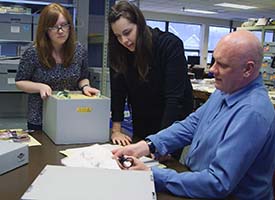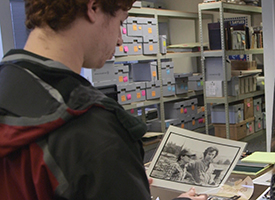Author, Auteur, Independent
Imagine allowing a class of undergraduate students — perfect strangers – to comb freely through your entire life’s work: childhood school papers, magazine articles, drafts of your novels and short stories, contracts, financial records, legal documents, personal letters, candid snapshots. . .
Oh, and then there are those journals, journals, and more journals — jammed with everything from profound artistic insights to the daily business of writing, directing, and releasing independent films.
This spring maverick filmmaker John Sayles and his producing partner, Maggie Renzi, opened their massive archive to students enrolled in Screen Arts & Cultures 455, “American Independent Cinema.” Housed at U-M’s Special Collections Library, the artists’ archive comprises more than 230 boxes of material spanning a four-decade collaboration in independent cinema. It offers rare insight into the director as actor, screenwriter, playwright, and novelist.
“We chose the University of Michigan over other excellent archives and libraries because we wanted to see John’s work studied as part of the curriculum at a great university,” says Renzi.
From her lips to the students’ ears.
Declarations of independence
In spring 2014, the Screen Arts & Cultures students collaborated to produce an exhibit titled “Sayles Pitch: John Sayles, Author, Auteur, Independent.” The walk-through display is open to visitors of the Hatcher Graduate Library through July 10. The exhibit complements the John Sayles Symposium June 4-5, held at U-M in conjunction with Ann Arbor’s annual Cinetopia International Film Festival, where Sayles will appear in person.
Developing an exhibit to be experienced by a mainstream audience infused the course with palpable energy, says Katherine Sherry, who just completed her junior year.
“It creates another level of involvement,” she says. “It’s not simply going to class, listening to a lecture, writing a paper. You’re actually learning about this person through their own documents. These are primary sources. It gives you a sense of ownership. It’s exciting and rejuvenating.”
A voice of social consciousness

Philip Hallman, film studies librarian at the U-M Library, reviews archival material pulled by students Laura Caruso and Katherine Sherry. (Image: Jonathan Hoard.)
Laura Caruso, intrigued by the business of filmmaking, found Sayles to be a very “teachable” person. For nearly every concept covered in the classroom she discovered a tangible example in the archive. His unique approach to financing, for example, was a huge revelation. In the late 1970s Sayles worked for infamous low-budget producer Roger Corman, and soon learned he could finance his own independent films through earnings as a screenwriter.
Sayles has penned about 100 screenplays, and has written and directed 18 of his own films. He garnered near-unanimous critical acclaim with his directing debut, the self-financed character study Return of the Secaucus 7, which he also wrote. His 1992 movie Passion Fish earned Academy Award nominations for best original screenplay for Sayles and best lead actress for Mary McDonnell. The Oscar-nominated Lone Star, set in a Texas border town, earned Sayles a best screenplay nod in 1997. He’s also published books, short stories, and plays. And, most importantly, as he continues to produce work, his archive will continue to grow.
What is particularly striking about this “living collection,” says Phil Hallman, film studies librarian at the U-M Library, is “John Sayles’ dedication to being John Sayles. And by that I mean his willingness to sacrifice other things in order to commit to his vision of what a filmmaker should be, what his role as an independent voice of social consciousness in America could be. He’s had many chances to be more commercial but he’s chosen not to and I really respect that.”
Caruso admits she didn’t know much about Sayles prior to enrolling in the course. “That may have been a benefit, because I could approach the project without any bias,” she says, before breaking into a huge grin. “But I’m biased now — because I love him.”
Surprise!
Since acquisition of the material is relatively recent, the library staff has yet to process everything. Sometimes students were the first “archivists” to open a box and identify its contents. “It was kind of like Christmas morning for them,” Hallman says. “They often had no idea what they’d find.”

Producing an exhibit for public consumption is “exciting and rejuvenating,” says student Katherine Sherry.
Melissa Gomis, instructional technology librarian in the graduate library, worked with the students to compile selected assets into a compelling narrative. The resulting exhibit covers a few key highlights that convey the creative, technical, and logistical processes that define the Sayles oeuvre:
- The first section examines the film Honeydripper as a case study in Sayles’ outside-the-system process.
- The second documents some of Sayles’ work across genres as a writer, credited and uncredited, on films ranging from the monster movie Alligatorto Apollo 13.
- The third considers his approach to the social, political, and economic realities of the people and places so intimately portrayed in his films.
- The fourth is a video display of multiple scenes, overlaid with an audio commentary track.
In addition, props, costumes, and other artifacts are displayed in the library’s Audubon Room.
Getting to know you

Mining the archive was a “tactile” experience, says student Katherine Sherry (second from right.) (Image: Jonathan Hoard.)
For aspiring screenwriter Audrey Weiner, Sayles’ handwritten notes, storyboards, and journals were especially revealing.
“There’s definitely a kinetic energy to reading his handwriting,” she says. “I think you can learn a lot about someone from the way they write — the actual way they write.”
Over time Weiner developed a detailed and nuanced portrait of both Sayles and Renzi.
“It’s really cool that you can take someone’s life, their journals and pictures, and make your own impressions of them without even meeting them,” she says. “I found a thank-you note from one of [Renzi’s] actors, and he said seeing her work inspired him to be more of an open person.”
Absorbing the contents of letters and notes — even college papers that were not relevant to the exhibit — helped students understand how aligned the partners always have been in their personal ideals and approach to storytelling. Sayles and Renzi often explore political unrest, class warfare, racial discrimination, and other provocative themes on the screen.
Mind over minutiae
It was important for the students to immerse slowly and completely in the minutiae of the archive to understand the complexity of independent filmmaking, Hallman says.
“So often I work with students whose first instinct is to Google something,” he says. “This is definitely the anti-Google approach. It’s a great opportunity to make the library come alive for students of the 21st century.”
It was “honestly weird,” says student-director Matt Birnholtz, to get the first look at what was going on behind the scenes of a particular Sayles film. Contributing to the exhibit has impacted how Birnholtz will approach his own work in the future. The sheer breadth and depth of the archive illustrates the diligence it takes to conceive, produce, market, and distribute independent films, he says.
“It’s incredible to see how much thought and effort [Sayles] puts into everything he does,” Birnholtz says. “There are thousands and thousands of pages in each box and you realize how many people contribute to every single location, every single shot, every single movie. It excites me to see how hard people work, and I’m excited to work that hard on films.”
Found in translation
Translating the students’ commentary and found artifacts into a series of exhibit panels was a unique storytelling challenge for librarian Gomis.
“An exhibit is a visual medium, and an archive is not,” she says. “You have to decide what to highlight, how to create a layout and flow that presents the entire story as a whole.”
The exhibit is designed to demystify the archive and make the library relevant to people who enjoy film and the arts, Gomis says.
“It gives members of the community a chance to learn about [Sayles] and understand why the University collects these things, and why a researcher would use them,” she notes.
Promoting the archive through the exhibit opens a window into the vast treasures students and others can find in the library system, Hallman says. During a recent follow-up meeting regarding the exhibit, one student discovered some assets he hadn’t yet seen, including photos and storyboards related to Sayles’ Bruce Springsteen videos “I’m on Fire,” “Born in the USA,” and “Glory Days.”
“He said, ‘Wow! We have this?'” says Hallman. “And you see how it becomes an avenue for him to come back and explore the archive some more. It’s like you just want to fill up on it. There’s never enough. And you hope this is the beginning of a lifetime commitment to being interested in this kind of material. That’s exactly what we want.”
 Visit Michigan’s World Class to read more stories about the University’s mission to support creative new ways to share knowledge, address issues of the day, and equip future leaders with skills and confidence.
Visit Michigan’s World Class to read more stories about the University’s mission to support creative new ways to share knowledge, address issues of the day, and equip future leaders with skills and confidence.








Matthew Zivich - 1960
My personal favorite movie of John Sayles is “Eight Men Out.” It has a great cast with some surprises such having the late Studs Terkel as one of the actors, as well as John Sayles himself. But I feel the movie has real staying power and each time I watch it, it doesn’t fail to be refreshing and never dated.
The topic of unethical behavior in sports is a touchy subject that is usually avoided in favor of portraying sports figures as super-heroes. “Eight Men Out” shows the vulnerability of athletes and creates an effective way of understanding the realities that affect sport figures as much as the rest of us.
Reply